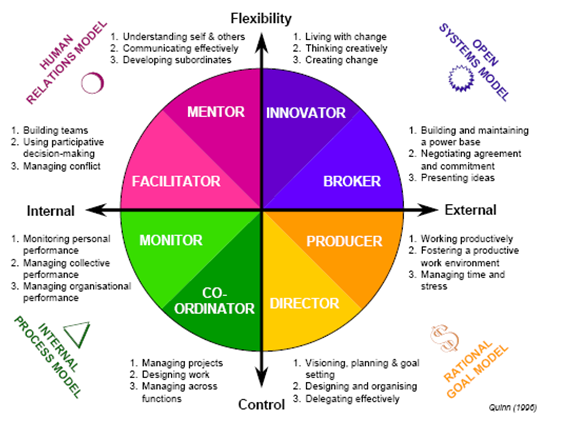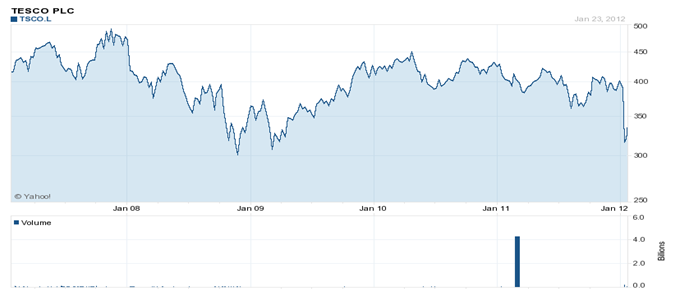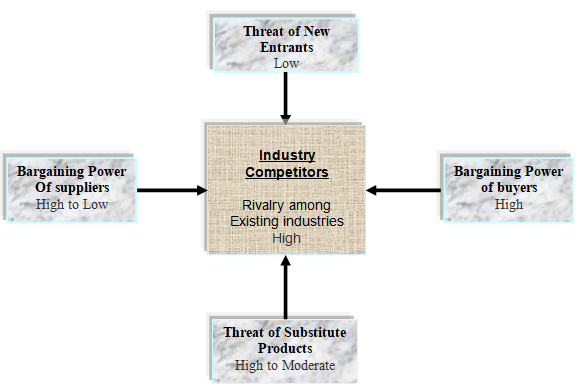Introduction: How Has Globalisation Affected Tesco?
There are many management theories provided by different researchers to develop the performance of the companies, but fortunately, Quinn’s Competing Values Framework (CVF) included all necessary elements of the management approaches.
Quinn, et al. (2003) stated that traditional models were ineffective in some extent; therefore, he provided the Competing Values Framework (CVF) for organisational analysis and it includes the two dimensions form four quadrants to demonstrate different assortment of organizational efficiency indicators and management theory, such as, the human relations model concentrates on building team, focusing internal conflict and understanding others.
The purpose of this model is to concentrate on the external factors to take internal decision in terms of human resource management, production, quality control, and time management to develop the performance of the company (Quinn, et al., 2003).
At the same time, Breen, Walo & Dimmock (2004, p.5) pointed out the view of Quinn and stated that CVF framework gives the opportunity to the managers to upgrade their performance as it included eight management role with twenty four competencies. According to the CVF model, each quadrant includes –
- Human relations model: This situates in the upper-left quadrant and it defines mentor role and facilitator role;
- Open system model: It is in the upper-right quadrant and it describes innovator and broker role;
- Internal process model: in the lower-left model contains monitor and coordinator role;
- Rational goal model: The lower-right quadrant includes producer and director role;

However, Boddy (2007) pointed out that management theory is a group of observations and policies intended to assist administrators of a corporation; moreover, it is a route of philosophy, governance, organisation, and set of guidelines by which the tasks of the company’s workers are carried out through utilisation of the obtainable resources and competencies for attaining explicit corporate objectives.
Griffin (2006) noted that a number of management approaches exist by which the companies can administer its internal operational processes.
For example, Robbins & Judge (2004) stated that dictatorial management approach is the technique of administration where managers take decision and juniors or low- level workers follow him; moreover, dictatorial managers take steps in more egotistical ways and decide more unilaterally; however, it is a less effectual and less elegant way to govern the organizations of the countries.
Conversely, autonomous approach focuses on delegation of authority, satisfaction, diversified, interesting, and rotated tasks, equal opportunities, team working, and most importantly, appreciation of good ideas and good performances from juniors.
Company Background of Tesco Store
Tesco Plc is the third largest retailer in the UK and it was established in 1919 as small grosser, but now it has business operation in fourteen countries along with it possesses 2,715 outlets in UK and 2,665 stores in other thirteen countries (Tesco Plc, 2011).
However, Tesco has over 472,000 efficient, talented, dynamic, and educated employees among them 4,134 employees recruit for the US market, more than 293,676 employees work for the UK market, 104,071 employees for the Asian countries, and 89,559 employees for the rest of the EU zone.
In addition, it offers diversify products and services including retail service, telecommunication, banking, ICT, club card, beauty salon and so on; however, the net profits and total assets of Tesco were about £2,671 million and £16,623 million accordingly in 2011 and more than £2,336 million and £14,681 million were accounted in 2010 (Yahoo Finance, 2012; and Tesco Plc, 2011).
Management at Tesco
According to BBC News (2001), historically, Tesco followed almost an autocratic model towards management of its operations; to specify, Sir Jack (one of the earliest chief executive officers at the company), possesses a chronicle that is often remembered by the successors for an autocratic management style.
However, in order to operate in a synchronized manner with the company’s subordinate workers and managerial staff, and to match up with the requirements of the twenty first century, it felt tempting to adopt a more liberal approach to manage the low and mid level employees and the day to day operations by transforming into a democratic business.
This factor is supported by Madslien (2005), who stated that Sir Terry, after becoming the CEO of the company in 2002, turned quite fanatical about all the features of Tesco; and as a result, substituted the previously forceful management style with an emotional contact between workers coupled with earnest openness.
Democratic style of management was a Rational Goal Model for Tesco Corporation because of the reason that it had all the abilities, resources, and relevant competencies required for administering the company in a way where delegation of authority and dependency over the intellects of the well- skilled and open- minded employees would not be a wrong decision.
SWOT analysis
Strengths
- Brand Awareness is the key strength of Tesco;
- The efficient and dynamic human resources are the key assets for the company;
- According to the annual report 2011, Tesco offers large product lines and services including insurance facilities and credit purchasing services;
- Moreover, Tesco Personal Finance is one of the most successful sectors besides retail services and it offers fully operated banking service;
- Tesco Plc (2011, p.66) stated that it follows ethical code of conduct and the provisions of Companies Act 2006, practices good governance to control the company;
- At the same time, shareholders are a key strength of Tesco because they are generating the ultimate investment capacity for the company;
- This company is the market leader of the local market and the large competitor of the international market where it has operation;
- Advance technology helps Tesco bring success and now it provides online purchasing facilities, online baking facilities and maintains customer relation;
- The market share is growing rapidly throughout the UK and international market, such as, Datamonitor (2004, p.14) stated that Tesco hold 13% market share of the UK retail superstores market;
- It has gained success for the continuous efforts the management team, for example, the CEO of Tesco Terry Leahy has taken many effective decisions, which helps increase its sales 71.0% larger than Sainsbury’s sales;
- However, high quality products and services, strong supply chain management system, long experiences, corporate social responsibility, and financial position are also strongest point for this company.
Weaknesses
- Datamonitor (2004, p.16) stated that Tesco generates maximum profits (73.80%) from the UK and only 26.2% revenue generates from other markets;
- On the other hand, Interference of media some time creates hindrance of the business, such as, television channel broadcast in a documentary and questioned on Tesco’s CSR by claiming that it encouraged and exploit child labour.
Opportunities
- Tesco has opportunity to introducing new products with low costs and implementing new strategies to gain profits in recession;
- The health care products of Tesco has great prospect in the global market; so, it invests regularly to develop this sector, and it has about 200 stores with pharmacies;
- It has scope to adopt brand expansion strategy as it has financial capabilities, efficient employees, and brand name.
Threats
- The main threat in retail business of Tesco is the strong competitors of local and international market, such as, ASDA as a subsidiary of Wal-Mart gain competitive advantages and Sainsbury PLC and Morrisons have huge participation in the market;
- Staff turnover rate is one of the main problems for the operation of international market as the employees would like to work at home if get better offer;
- Tesco has suffered financial lose from some international market because of the negative impact of the global economic downturn though integrated net profit was stable position;
- At the same time, Datamonitor (2004, p.17) reported that frequent change of customer behaviour, foreign direct investment policy of overseas government, and entry barriers, local regulation, listing requirements and low price offerings for the similar products also threats for the company.
PESTEL Analysis of Tesco
- Political factors: Tesco Plc has business operation in fourteen countries in three continents; therefore, the performance of this company extremely depends on the political and legal conditions of these countries, such as, taxation policy, hostile attitude of the government of new markets, unfriendly approach of international market, unstable political condition of certain area, and so on;
- Economic factors: The external economic position of the market influences the company; however, Tesco experienced profits in recent years in spite of global recession; however, the following chart demonstrates that the share price of Tesco is quite position in London Stock Exchange (LSE)-

- Socio- cultural factors: Tesco Plc (2011) stated that it follows same business model for all countries, but it concentrates on the local culture. In addition, it maintains good governance to provide equal treatment of the employees and to give service to the shareholders;
- Technological factors: Tesco uses automated weather forecasting technology that perfectly adjusts store orders and deliveries derived from customers’ shopping behaviour in different weather conditions in fourteen individual areas; however, it also uses Information Technology, the Efficient Consumer Response (ECR), Wireless devices, Radio Frequency Identification, hand-held technology, and so on;
- Legal Factors: Tesco Corporation (2004) stated that it follows the rule and regulation to operate its business and The Corporate and Legal Affairs Department are responsible for the legal matters;
- Environmental Factors: According to the annual report 2011, this company has made further development towards its objective to be zero-carbon business by generating energy from renewable sources by 2050 and it declined CO2 emissions from its baseline portfolio of buildings by 7.70%; in addition, it introduced green retailing to assist customers and suppliers to cut CO2 footprint.
Porter’s five forces model analysis of Tesco
This framework helps the company to measure profitability level; however, the following figure shows the Porter’s five forces model of Tesco Plc more specifically –

- Threats from new entrants: In accordance with the annual report 2011 of Tesco Plc, both the retail and wholesale market have faced aggressive competition last year due to unrest political and economic situation all over the world; therefore, it becomes difficult for the companies to enter new markets with new product line. However, the threats of new entrants are low since it involves too many issues, such as, relationship with suppliers, distribution channels, high investment, competition from local players, and so on;
- Bargaining power of buyers: Tesco Plc (2011) reported that success of the company mostly depends on the loyal customer base and Tesco is creating value for customers and offering special scheme; however, the customers of this company consider quality of the products. At the same time, the bargaining power of the buyers is comparatively high as switching off costs is very low and there are many players in the global market both in retail and wholesale sector;
- Bargaining power of suppliers: The bargaining force of suppliers differs considering the brand value of the suppliers, international market, external business environment, availability of the raw materials, terms of the agreement, natural crisis, and so on;
- Threats of substitute products: Threats of substitute products is comparatively high as both local and multinational companies produce similar products and offer competitive price with innovative features for their products;
- Rivalry among existing firms: Tesco has many direct competitor (Wal-Mart, Sainsbury Plc, Carrefour, Morrison, Marks and Spencer) and indirect competitors all over the world and the rivalry among the firms is enormous because of frequent change of demand, low switching off costs, lack of CSR practice, complicated provisions to operate in international market and low price strategy of the competitors.
Impact of Globalisation on Tesco
Al-Rodhan (2006) provided the definition of globalisation as a course of action that encompasses the causes, routes, and outcomes of translational and trans-cultural amalgamation of human activities without any border barrier with the aim to ensure easy access for the multinationals everywhere is the globe.
Globalisation is a political agenda that rooted to influence the world to welcome multinational corporations for an unparalleled competition with the local small corporations that make the national business communities to surrender their own markets for Multinational Corporations (MNCs), at the same time, it destroys local culture and civilisation and restructures them, as it needed for MNC’s market expansion.
In the name of trade liberalisation, the development agencies like WTO, IMF World Bank and other international agencies create pressure to the less developed nations to create and modify existing legislation by which MNCs can get easy access in that region and by doing so they continue economic exploitation along with cultural aggression.
Thus, without any doubt it is good for developed nations and their multinationals, but bad for less developed nations and their national business communities.
Impact on Tesco
According to the annual report 2011, the vision of Tesco is to create loyal customer all over the world and this company is implementing globalization strategies to gain its goal within the next few years; therefore, it opens new outlets in India. In order to do so, Tesco tries to enter new market with its existing products along with products those produce concentrating on the demand and culture of the new markets.
As more than 157 countries are the member of World Trade Organisation, it becomes easy for Tesco to enter new markets with flexible provisions, low tariffs, and taxation policy of the new markets; however, Tesco experienced many entry barriers to implement this strategy at the initial stage.
In this context, the management team of this company has taken many strategies to enter new market with flexible ways, such as, Tesco formed joint venture agreement with the foreign companies to enter new markets like in 1999, Tesco entered South Korean market by joint venturing with Samsung (Icmindia, 2006).
On the other hand, The Telegraph (2012) reported that Tesco entered into the Indian market (the Tesco Hindustan Service Centre) by franchise agreement with Trent, the retail section of the Tata Group because India lifted FDI restrictions for overseas supermarket giants to save local players in this industry from the adverse impact of globalization and unparallel competition with multinational companies.
However, the following figure shows the condition of Tesco in foreign market –

Recommendation
- Tesco has already taken many actions in order to take advantage of the opportunities offered by globalisation; however, it should need to concentrate on the expatriate management, as the executives need to deal with the employees of different culture and background;
- On the other hand, CVF model specifically mentioned leadership roles, which will help Tesco achieve its goals in the future;
- To develop the European or Asian markets, it should increase the range of new products and Tesco should carry on cost leadership strategy
Conclusion: Tesco Goals
This report discusses PESTAL factors, Porter five forces model, strengths, weaknesses, opportunities and threats, the impact of globalisation, management theory for Tesco to operate its business in national and international market and to describe present position of this company.
At present, Tesco follows globalisation strategy in order expands its business new market, but it has to face severe entry barriers, which influence the company to enter joint venture agreement with local companies and share its resources.
Reference List
Al-Rodhan, N. R. F. (2006) Definitions of Globalization: A Comprehensive Overview and a Proposed Definition. Web.
BBC News (2001) Tesco: East End to East Asia. Web.
Boddy, D. (2007) Management: An Introduction. 4th ed. London: Prentice Hall.
Breen, H. Walo, M. & Dimmock, K. (2004) Assessment of tourism and hospitality management competencies: a student perspective. Web.
Datamonitor (2004) Tesco a Corporate Profile. Web.
Griffin, R. W. (2006) Management. 8th ed. New York: Houghton Mifflin Company.
Icmindia (2006) Tesco’s Globalization Strategies and its Success in South Korea. Web.
Madslien, J. (2005) Profile: Tesco chief Sir Terry Leahy. Web.
Quinn, R. E. et al. (2003) Becoming A Manager: A Competency Framework. 3rd ed. New York: John Wiley & Sons Inc.
Robbins, P. S. & Judge, A. T. (2004) Organisational Behaviour. 12th ed. London: Prentice Hall.
Tesco Corporation (2004) Tesco Corporation: Business Ethics Policy. Web.
Tesco Plc (2011) Annual Report 2011 of Tesco. Web.
The Telegraph (2012) Tesco and Walmart could move into India to solve country’s food problems. Web.
Yahoo Finance (2012) Basic Chart of Tesco for 2007 to 2011-05-02. Web.
Yahoo Finance (2012) Income Statement of Tesco Plc. Web.